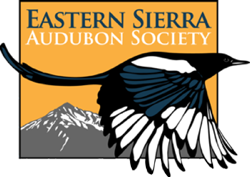Mono Highlands Important Bird Area
Text and photos from National Audubon Society IBA Database Site Profile
Mono Highlands Site Description
This IBA encompasses two ranges near the Nevada border in Mono County, the Bodie Hills in the north and Glass Mountain in the south. The Bodie Hills form a vast area of rolling, high-elevation (>8000') sagebrush tracts and stringers of riparian woodland extending from the Mono Lake Basin north to the Bridgeport Valley. The famous ghost town of Bodie, now a State Historic Park, lies near the center of hills that are otherwise undeveloped, with few roads. Glass Mountain separates Adobe Valley from the Crowley Lake area to the south, and also features extensive tracts of sagebrush, along with mixed conifer forest (Jeffrey Pine with Lodgepole Pine at highest elevations) isolated from that of the Sierra Nevada. The Glass Mountain area was the subject of an intensive breeding bird atlas effort (D. Shuford, unpubl. data).
Conservation Issues
The BLM has managed to reduce grazing pressure in key areas within the Bodie Hills, and fended off a proposal from gold mining (J. Fatooh, pers. comm.). The Glass Mountain area is fairly remote and lightly used, and reasonably well managed by the USFS.
Ornithological Summary
This IBA is notable for its large population of Greater Sage-Grouse, part of the Mono County metapopulations that appear to be genetically distinct from other groups in the Great Basin (J. Fatooh, pers. comm.). The sagebrush habitat within the Bodie Hills seems especially lush and intact in contrast to other tracts in the region that have been burned, over-grazed, or otherwise impacted by human activity (e.g. Long Valley). Vesper Sparrows breed in abundance, as do White-crowned Sparrows, occurring in isolated population islands (ES). Glass Mountain supports some of the highest densities of nesting Long-eared Owl in the state, as well as an unusual, high-elevation nesting population of Northern Harrier (DS). Songbirds are concentrated in riparian thickets, which are filled with fruiting currants (Ribes spp.) in fall that attract large numbers of migrant songbirds.
Help us learn more about the birds at this IBA! Enter your birding data online at California eBird! (http://ebird.org/california/)
Click here for a bar chart of eBird observations in the Mono Highlands


